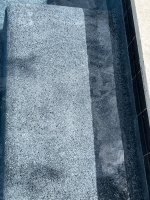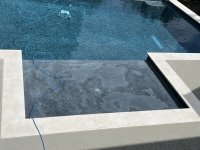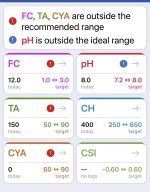Brand new pool completed in March. PH has been an ongoing issue in that it's higher than it should be. I know that's not uncommon in new pools but trying to understand the best course of action, and how much muriatic acid we should be adding in an effort to bring it down. Here are our #s from the past month from our pool service company:
Aug. 19:
10 ppm total chlorine
8.0 ppm pH
150 ppm total alkalinity
30 ppm cyanuric acid
Aug. 12:
3 ppm total chlorine
8.0 ppm pH
100 ppm total alkalinity
0 ppm cyanuric acid
0 ppm total bromine
Aug. 5:
5 ppm total chlorine
8.0 ppm pH
120 ppm total alkalinity
0 ppm cyanuric acid
July 30:
10 ppm total chlorine
8.0 ppm pH
90 ppm total alkalinity
0 ppm cyanuric acid
July 22:
20 PSI filter psi
3400 ppm salt
0 ppm total chlorine
8.2 ppm pH
120 ppm total alkalinity
As you can see, we've been consistently sitting right around 8 which is more or less where it's been since March. The guys who maintain our pool pretty regularly add muriatic acid, but I'm wondering if we should also be adding some throughout the week (they come 1x/wk on Fridays). (Side note: we do plan to take over our own maintenance once we get more comfortable with the test kit we bought - plus we've been gone for the past month so needed someone here to maintain.)
We are also now seeing some major "blotchiness" throughout our pool; you can see it most closely on this pic of the sundeck but it is throughout the entire pool. I fear this is calcium scaling and potentially related to the high pH? But again, super confused because I've frequently heard that pH runs high for new pools for quite some time.
Appreciate any advice!
Aug. 19:
10 ppm total chlorine
8.0 ppm pH
150 ppm total alkalinity
30 ppm cyanuric acid
Aug. 12:
3 ppm total chlorine
8.0 ppm pH
100 ppm total alkalinity
0 ppm cyanuric acid
0 ppm total bromine
Aug. 5:
5 ppm total chlorine
8.0 ppm pH
120 ppm total alkalinity
0 ppm cyanuric acid
July 30:
10 ppm total chlorine
8.0 ppm pH
90 ppm total alkalinity
0 ppm cyanuric acid
July 22:
20 PSI filter psi
3400 ppm salt
0 ppm total chlorine
8.2 ppm pH
120 ppm total alkalinity
As you can see, we've been consistently sitting right around 8 which is more or less where it's been since March. The guys who maintain our pool pretty regularly add muriatic acid, but I'm wondering if we should also be adding some throughout the week (they come 1x/wk on Fridays). (Side note: we do plan to take over our own maintenance once we get more comfortable with the test kit we bought - plus we've been gone for the past month so needed someone here to maintain.)
We are also now seeing some major "blotchiness" throughout our pool; you can see it most closely on this pic of the sundeck but it is throughout the entire pool. I fear this is calcium scaling and potentially related to the high pH? But again, super confused because I've frequently heard that pH runs high for new pools for quite some time.
Appreciate any advice!




